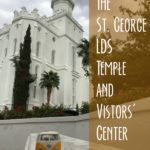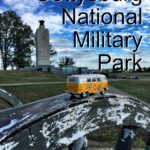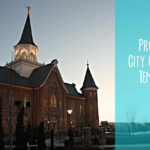A place becomes sacred because of what happens there. Gettysburg which I wrote about last week, became a hallowed place because of the sacrifice men made while there. It became sacred because of what was lost, in contrast the area formerly known as Harmony, Pennsylvania is sacred to the Latter-day Saints (Mormons), not because of what was lost but because of what was restored there. Priesthood, the power of God given to man, had been absent from the earth for centuries and in this nondescript corner of the world it was brought back. For more on the history please see this link.
The LDS church has just recently done a full scale rebuilding of the site complete with visitor center/chapel, rebuilding of the Smith and Hale homes on their original foundations, and easier access to the river. Having served as a missionary in Northern Pennsylvania when there was still nothing but a single monument and earthen mounds over the foundations this recent visit was very emotional for me.
How to Get There:
The chances of you ever just happening to be passing by the Priesthood Restoration site are extremely slim. The town of Susquehanna, Pennsylvania where it is now located is very small and out of the way. You will get to the site on Highway 171, it is on this Highway so that is the only road you can take to get there. Depending on which direction you are coming from you might come in on I-81 which is the closest interstate to the site. A lot of people will likely come from New York because they will be visiting other LDS church history sites in the Palmyra area. They will come South on I-81 and the head East when it junctures with Highway 171.
In the old days there use to be a small parking lot next to granite shaft that memorialized the event of Priesthood restoration and that was what you would see first. With the reconstruction of the site there is now a beautiful chapel on the property that has a visitor center inside it and much larger parking lot. You will the see the church, you can’t really miss it, but you might miss the driveway which runs along the steeple side of the church.
What You Will See:
Visitor Center/Chapel
When you park in the parking lot the visitor center will be the doors on your far right, next to the statue depictions of the Priesthood restoration. Enter through these doors and you will immediately be greeted by missionaries who will help you know where to go and what to do. Immediately inside the doors is a scale model/map of the whole site. You can press buttons along the outside edge to have a light highlight different areas.
When we arrived at the visitor center they were just ready the begin a tour so we went right in to the movie that shows a dramatized version of the events that happened here. The movie is the beginning of the tour. The film is about 20 minutes long and is actually quite good it is a new film that was made especially for this new visitor center and both Meagan and I really enjoyed it.
If you arrive in between film showings you will have time to look around the visitor center before your official tour begins. It is a very impressive visitor center, one of the best I think I’ve been to. With my degree in instructional design I tend to look at visitor center/museum spaces with an eye towards learning, and in particular interactive learning. This visitor center focuses just on the events that took place here in LDS history, so it is not super large but you could spend a significant amount of time if you do and read/watch everything.
Site Tour
Once you finish the movie a set of missionaries (either two sisters or a senior couple) will take you on a tour of the site. You will see the statues outside and then go past the sugar maple bush where historians guess the restoration of the Aaronic priesthood took place. Then you will pass under the highway in a tunnel that will take you to the Smith and Hale homes.
The tour will take you first through the Hale home and then through the Smith home. I won’t go into all the history here because I want you to go there and learn it. But I will say that these homes are beautiful restorations. They don’t know too much about how they would have exactly looked inside, but they have mostly used real period pieces to furnish them and taken their best guess based on records at what they would have looked like.
Cemetery
When you finish the official tour you will be free to walk around the site at your leisure and this is when you can visit the cemetery which is just a short walk away. In this cemetery you will find the graves of Emma’s parents, the Hales, and the first child of Joseph and Emma who died shortly after birth.
You can see the cemetery from the Smith house where your tour ends, but finding the graves can be slightly tricky if you don’t know where they are or what you are looking for. If you get lost just ask the missionaries, they can help you. If you are walking from the Smith home just keep left and head almost all the way to the far end of the cemetery. Look for two new looking headstones, the reason you are looking for new ones is because the old headstones have been encapsulated in more modern ones in order to preserve them and you can only see the new side when walking from the home sites.
The two Hale headstones are easier to find because they are together, but one you do the grave of the Smith baby is just a few plots away.
Old Monument
As I mentioned before this granite shaft with a relief carving of John the Baptist restoring the Aaronic Priesthood to Joseph Smith and Oliver Cowdrey used to be the memorial for the entire site. It is still impressive and has an important history of its own. It was purchased in 1960 using funds donated by boys who held the Aaronic priesthood from around the world.
Sugar Maple Bush
You can stop at the sugar maple bush on your way back to the visitor center. The words bush is a bit of a misnomer in this day and age because people probably think of a single shrub. It is more of a grove, and if you have visited the Sacred Grove in Palmyra, New York this will probably remind you of there. There are paths and benches through the area making it a good place to walk, sit, and ponder.
Susquehanna River
You will have to drive to the river site which is either at or near where the baptisms of Joseph and Oliver took place. The river is actually very close to the old monument, but a railroad line runs between them making it so you can’t walk there. For this reason it is often the last place people visit at this site. When you leave the visitor center turn left onto the highway. A short way down the road you will see a large blue sign showing you where to turn to get the river. You follow this road over the railroad tracks and then to the right until you reach the end of the road and the head of the trail that leads down to the river.
The trail will take you down to the river to the area where it is likely that Joseph and Oliver’s baptisms took place. This a peaceful and beautiful spot to visit and to stand for a moment and ponder.
Sum Up:
This is a great site to visit. There is no cost for visiting and it is excellently set up to help you understand the history of the site and the doctrinal significance of it to the Latter-day Saints. All the trails are fully accessible so it is fine to bring strollers and wheel chairs on them, although I don’t think they can get them inside the houses. You should expect to spend anywhere from 1-3 hours here.








